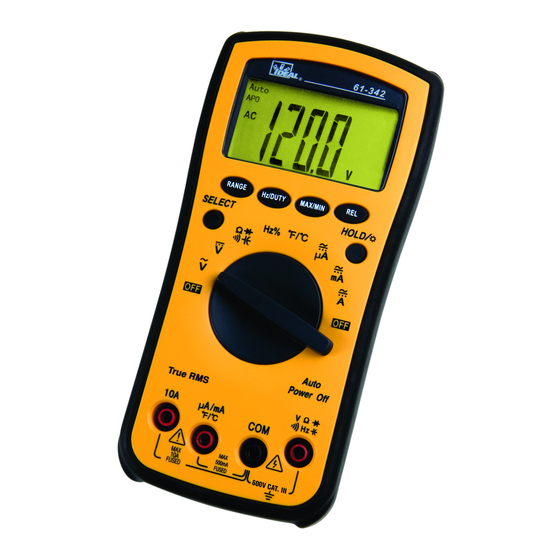
IDEAL 61-340 Instruction Manual
Hide thumbs
Also See for 61-340:
- Instruction manual (43 pages) ,
- Manual (2 pages) ,
- Instruction manual (6 pages)
Advertisement
Available languages
Available languages
ND 6447-1 61-340 61-342 Ins
3/17/08
6:42 AM
#61-340
Read First: Safety Information
Understand and follow operating instructions
#61-342
carefully. If this tester is not used in a manner
specified by IDEAL, protection provided by the
product may be impaired.
WARNINGS
Digital Multimeter
To avoid possible electric shock, personal injury or
Instruction Manual
death follow these instructions:
• Do not use if meter appears damaged.
• Visually inspect the meter to ensure case is not
cracked and back case is securely in place.
• Inspect and replace leads if insulation is dam-
aged, metal is exposed, or probes are cracked.
Pay particular attention to the insulation sur-
rounding the connector.
• Do not use meter if it operates abnormally as
protection maybe impaired.
• Do not use during electrical storms or in wet
weather.
• Do not use around explosive gas, dust, or vapor.
• Do not apply more than the rated voltage to the
meter.
• Do not use without the battery and the back case
properly installed.
• Remove the test leads from the meter before
removing battery cap.
• Do not attempt to repair this unit as it has no
user-serviceable parts.
• Disconnect power and discharge capacitors
before testing resistance, continuity, diodes,
capacitance or temperature.
• Replace battery as soon as low battery indicator
appears to avoid false readings.
+
• Use the proper terminals, function and range for
your measurements.
• Comply with local and national safety
requirements, including the use of appropriate
personal protective equipment.
CAUTION:
To protect yourself, think "Safety First":
• Voltages exceeding 30VAC or 60VDC pose a
shock hazard so use caution.
• Use appropriate personal protective equipment
such as safety glasses, face shields, insulating
gloves, insulating boots, and/or insulating mats.
Page 1
• Before each use:
- Perform a continuity test by touching the
test leads together to verify the functionality
of the battery and test leads.
- Use the 3 Point Safety Method. (1) Verify
meter operation by measuring a known
voltage. (2) Apply meter to circuit under
test. (3) Return to the known live voltage
again to ensure proper operation.
• Never ground yourself when taking electrical
measurements.
• Connect the black common lead to ground or
neutral before applying the red test lead to
potential voltage. Disconnect the red test lead
from the voltage first.
• Always work with a partner.
• When using the probes, keep fingers as far
behind the probe tips as possible.
Symbols
Risk of electric shock
See instruction card
DC measurement
Equipment protected by double or
reinforced insulation
Battery
+
Earth
~
AC measurement
Conforms to EU directives
Ranges & Accuracies:
AC Converter: 61-340 model is averaging
sensing, rms calibrated; 61-342 model is true rms
sensing.
Accuracy: Accuracy is specified as +/-(a
percentage of the reading + a fixed amount) at
23°C±5°C (73.4°F ± 9°F), less than 75% relative
humidity.
Temperature Coefficient: 0.1 times the
applicable accuracy specification from 32°F to
64°F and 82°F to 122°F (0°C to 18°C ; 28°C to
50°C).
Ranges & Accuracies
~
AC Voltage (V
)
Toggle for
Frequency
(>20% of
range)
DC Voltage (V )
DC
Advertisement
Table of Contents

Summary of Contents for IDEAL 61-340
- Page 1 #61-342 carefully. If this tester is not used in a manner test leads together to verify the functionality Toggle for specified by IDEAL, protection provided by the of the battery and test leads. Frequency product may be impaired. - Use the 3 Point Safety Method. (1) Verify (>20% of...
-
Page 2: Specifications
600 volts potential. depress to exit °C Safety Complies with UL/IEC/EN 61010-1, IDEAL product, including but not limited to implied • Duty cycle: 15sec ON / 15min OFF for mode. Certification: 61010-031, Cat III-600V warranties of merchantability and fitness for a par- 10A MAX ticular purpose, are limited to the above. - Page 3 Alcances y exactitudes: lecturas falsas. Conversor de CA: El modelo 61-340 es con • Use los terminales, la función y el alcance sensado de promedio, calibrado en valor eficaz; el apropiados para sus medidas.
-
Page 4: Especificaciones
600 V. °C de operación: a < 75% de H.R oprimir para salir de un producto IDEAL, incluidas -pero sin limi- • Ciclo de trabajo: 15 s activado / 15 min Ambiente de -4° a 140°F (-20° a 60°C) del modo. - Page 5 Plages et précisions : • Se conformer avec toutes les exigences locales et nationales en matière de sécurité, y compris Convertisseur c.a. : Le modèle 61-340 assure l'utilisation du matériel de protection personnel une détection par calcul de moyenne, le modèle adéquat.
-
Page 6: Spécifications
Polarité : Automatique (pas libérer l'affichage. renseignements concernant l'entretien-dépannage, Basculer d'indication de polarité se mettre en rapport avec IDEAL INDUSTRIES, INC. pour AC Mini/Maxi positive) ; Signe moins (-) Au 1-877-201-9005 ou visitez notre site web pour la polarité négative Bonne diode www.testersandmeters.com...















Need help?
Do you have a question about the 61-340 and is the answer not in the manual?
Questions and answers